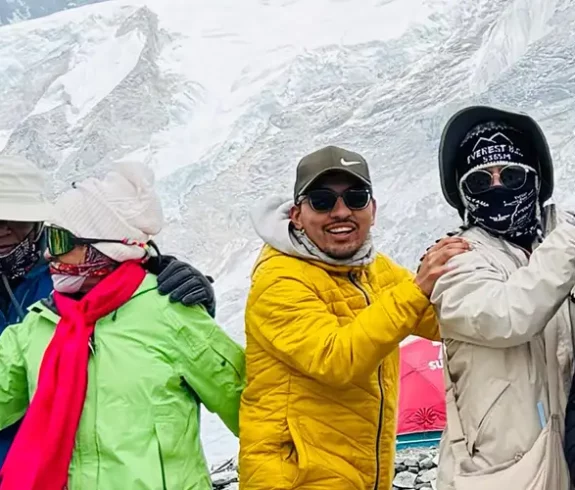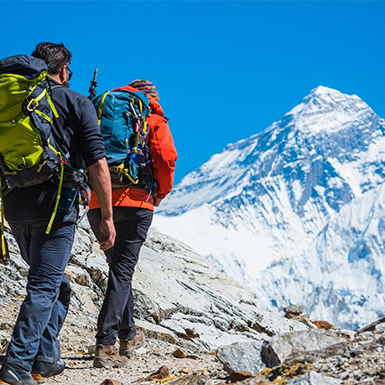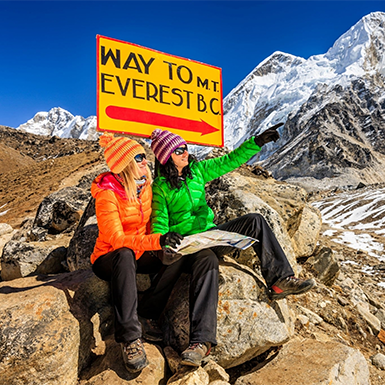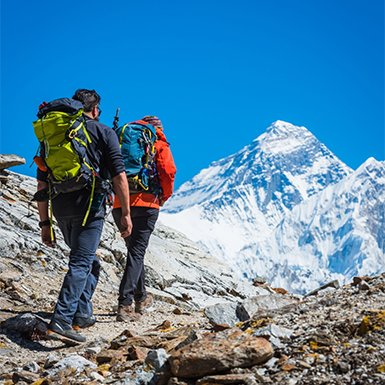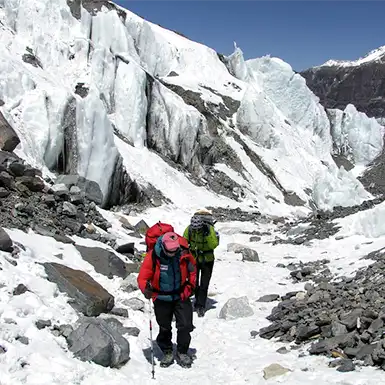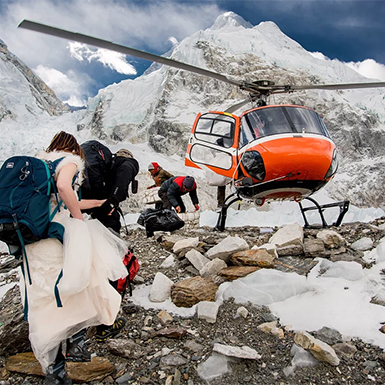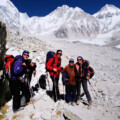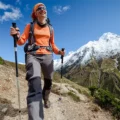Nestled amidst the Himalayas, Everest Base Camp (EBC) is a beacon of human determination and the irresistible draw of conquering Mount Everest, the planet’s tallest peak. This elevated haven is the starting point for daring mountaineers with their sights set on the summit. Steeped in a rich history of expeditions and boasting a unique geographic location, Everest Base Camp holds a distinguished place in mountaineering.
A Look Back: Expeditions and Significance
EBC has witnessed countless expeditions, each adding to our collective knowledge of high-altitude mountaineering. The historic ascent of Mount Everest by Sir Edmund Hillary and Tenzing Norgay in 1953 solidified the base camp’s status as a crucial launching point for future expeditions. Since then, EBC has become a hub for climbers, researchers, and adventurers, fostering a sense of community and shared purpose.
The historical significance of the base camp reaches beyond its role in summit attempts. It has functioned as a platform for scientific research, medical studies, and cultural exchange. The demanding environment and extreme altitude of EBC have yielded valuable insights into human physiology and adaptation, propelling advancements across various fields.
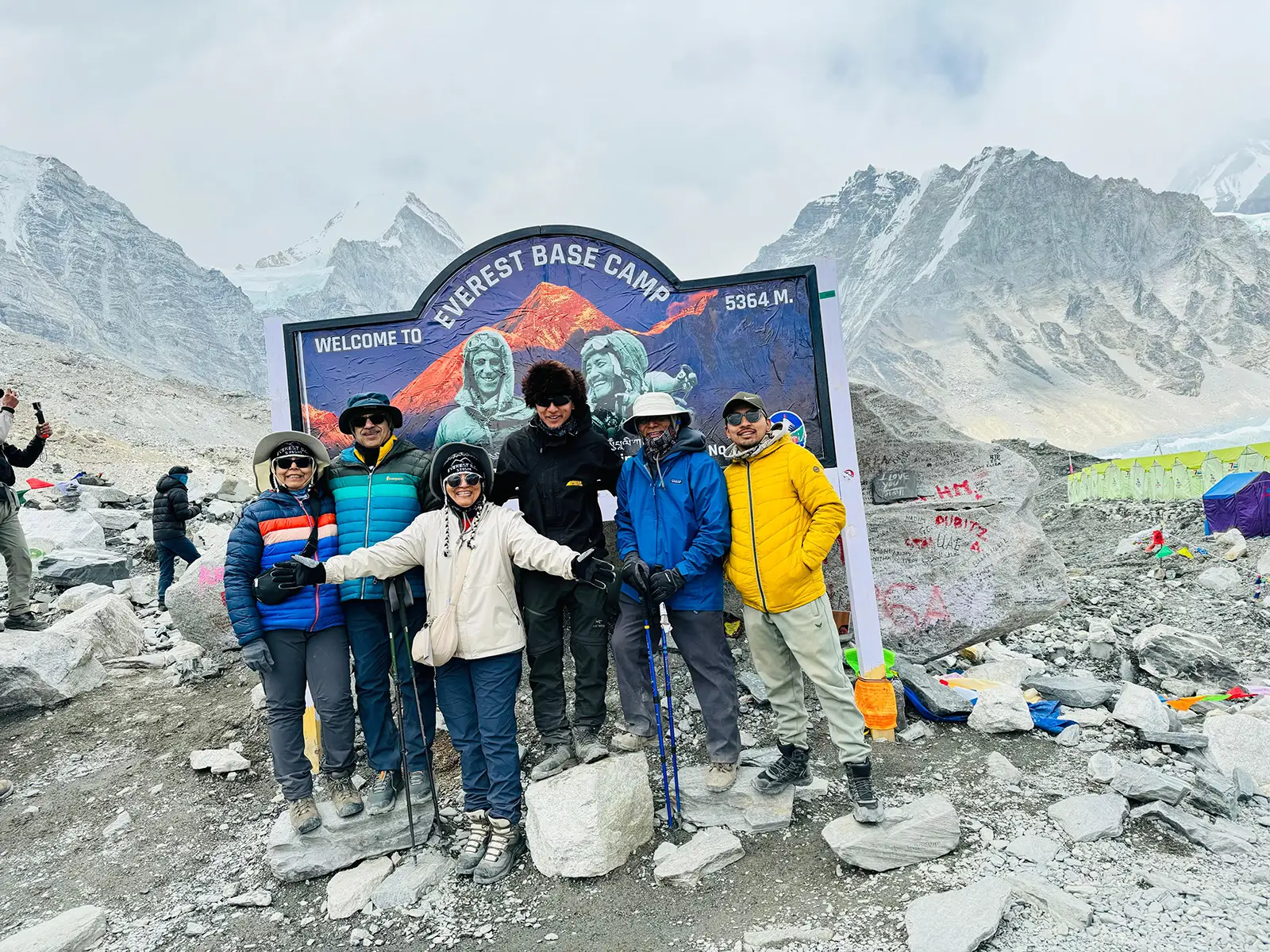
Geographic Location: The Gateway to the Summit
Everest Base Camp is strategically situated in Nepal, perched at an elevation of roughly 5,364 meters (17,598 feet) above sea level. This lofty height places it squarely in the “death zone,” where oxygen levels plummet, and the risk of altitude sickness intensifies. Despite this, the base camp’s proximity to the Khumbu Icefall, the initial major hurdle on the route to the summit, renders it an indispensable launching point for climbers.
The trek to Everest Base Camp typically commences in Lukla, a small town reachable by a thrilling mountain flight. From Lukla, trekkers navigate established trails that meander through Sherpa villages, lush forests, and glacial valleys. The trek is rewarding, showcasing breathtaking Himalayan landscape vistas and offering chances to delve into the local Sherpa culture.
Reaching the Heart of the Himalayas: Your Everest Base Camp Trek
Everest Base Camp Nepal captivates countless treks annually with its extraordinary expedition. With its awe-inspiring landscapes, demanding trails, and the magnetic pull of standing beneath the world’s highest peak, it’s no surprise that EBC is a coveted goal for many. But how exactly do you get there? Let’s delve into the various routes and what awaits you on this incredible trek.
Choosing Your Path to Everest Base Camp
Multiple routes lead to EBC, each offering unique appeal and obstacles. The most popular choice is the classic trek from Lukla, a small town in Nepal’s Khumbu region. This typically takes 12-14 days roundtrip and treats trekkers to stunning vistas, cultural immersion, and ample time to acclimate to the high altitude.
Other options include the Gokyo Lakes trek, a detour to the mesmerizing turquoise glacial lakes of Gokyo, and the Three Passes trek, a more demanding route that crosses three high mountain passes. Whichever path you select, prepare yourself for a physically challenging but enriching trek.
Lukla: Your Gateway to the Everest Region
Most EBC treks begin with a scenic flight to Lukla’s Tenzing-Hillary Airport, one of the world’s most thrilling and highest airports. From there, the trail meanders through Sherpa villages, rhododendron forests, and suspension bridges, gradually ascending as you approach the heart of the Everest region.
Trekking Time and Daily Distances
On average, the trek from Lukla to Everest Base Camp takes 8-9 days, covering approximately 65 kilometers (40 miles). The return trip usually takes 3-4 days. Daily distances can vary depending on your specific itinerary and acclimatization needs, but you can anticipate hiking for 5-7 hours each day.

When to Go and What to Expect
Choosing the ideal time to visit Everest Base Camp (EBC) depends entirely on your preferences and priorities. However, two seasons reign supreme for most trekkers: spring (March-May) and autumn (September-November). These periods offer the most pleasant weather, stable trails, and crystal-clear views of the awe-inspiring Himalayan peaks.
Spring (March-May): Nature’s Colorful Rebirth
Spring brings warmer temperatures, blossoming rhododendrons, and a lively atmosphere to the Everest region. The days longer, the skies remain mostly clear, and the threat of snowfall is minimal. This picturesque backdrop is perfect for capturing stunning Everest Base Camp photos as the landscape explodes with color and life.
Remember that spring marks the peak trekking season in Nepal, so expect bustling trails and tea houses. Consider early March or late May visits if you crave a more tranquil experience.
Autumn (September-November): Crisp Air and Festive Cheer
Autumn ushers in another excellent weather window for the EBC trek. The monsoon rains clear the air, revealing breathtaking panoramic mountain views. While days remain pleasantly warm, nights can turn chilly, so pack warm layers.
Autumn also marks a festive period in Nepal, with vibrant celebrations throughout the region. The cultural richness infuses your trek, but remember that tea houses and lodges may fill up quickly, so reserve your accommodations early.
Off-Season Treks: Winter’s Chill and Monsoon’s Lushness
Although spring and autumn are the best times for the Everest Base Camp trek, some treks opt for the off-season.
- Winter (December-February): The Everest region experiences harsh weather conditions during winter, with heavy snowfall and frigid temperatures. However, you’ll encounter fewer fellow trekkers, and the snowy landscapes possess a unique allure. Winter trekking presents a rewarding challenge for experienced trekkers who must wear appropriate gear and prepare.
- Monsoon (June-August): The monsoon season brings substantial rainfall, rendering trails muddy and slick. Cloud cover often obscures views. While trekking during the monsoon isn’t recommended, it’s an ideal time to explore local culture and revel in the lush greenery of the lower valleys.
Tailoring Your Trek to Your Preferences
The perfect timing for your EBC trek ultimately depends on what you value most in your trekking experience. Here are vital factors to consider:
- Weather: Do you enjoy warm, sunny days, or are you prepared for cooler temperatures and potential snowfall?
- Crowds: Do you embrace the lively energy of crowded trails and tea houses or seek solitude?
- Scenery: Are you captivated by vibrant rhododendrons and lush greenery, or do you find the austere beauty of snow-capped peaks more appealing?
- Cost: Are you budget-conscious or willing to invest in peak season prices?
Your Essential Preparation Guide
A successful Everest Base Camp Trek requires meticulous planning, including understanding essential permits, fees, and health considerations. This all-inclusive guide will equip you with the crucial steps to begin your extraordinary EBC trek.
Secure Your Permits and Pay the Fees
Before you hit the trails to Everest Base Camp, you’ll need to obtain a few crucial permits:
- Sagarmatha National Park Entry Permit: This permit grants access to the park, where you’ll find EBC. Get it at the Nepal Tourism Board office in Kathmandu or the park entrance in Monjo.
- Khumbu Pasang Lhamu Rural Municipality Entrance Permit: This permit is mandatory for entering the Khumbu region, home to EBC. You can obtain it upon arrival at Lukla airport or the tourism office in Namche Bazaar.
Get in Shape for the Challenge
You absolutely must be physically fit to undertake the EBC trek. Start training months ahead, focusing on building your cardiovascular endurance and strength and adapting to higher altitudes. Here are some training tips:
- Cardiovascular Exercise: Activities like hiking, running, or cycling boost your stamina. Aim for 3-4 hours of exercise each week.
- Strength Training: Strengthen your legs, core, and back with exercises like squats, lunges, and planks.
- Altitude Acclimatization: Gradually increase your elevation during training hikes to prepare your body for Everest Base Camp height.
Health Matters and Altitude Acclimatization
The high altitude of Everest Base Camp can pose health risks, so talk to your doctor before starting your trek. They can advise on vaccinations, medications, and any pre-existing conditions needing special attention.
Acclimatization is crucial in preventing altitude sickness during your trek. Ascend gradually, take frequent breaks, and drink plenty of water. Listen to your body’s signals. Descend right away if you experience symptoms like headache, nausea, or dizziness. Here are some acclimatization tips:
- Slow and Steady: Avoid climbing more than 500 meters (1,640 feet) per day.
- Rest Days: Schedule rest days that are significantly above certain altitudes.
- Hydration is Key: Replenish fluids frequently to prevent dehydration.
- Skip the Alcohol and Caffeine: These substances can dehydrate you and exacerbate altitude sickness.
Be Prepared for an Epic Trek
By securing the necessary permits, getting in top physical shape, and prioritizing your health and acclimatization, you’ll be ready to conquer the trails leading to Everest Base Camp. Remember, a well-prepared trek is a safe and enjoyable one. Proper preparation will make your EBC experience unforgettable.
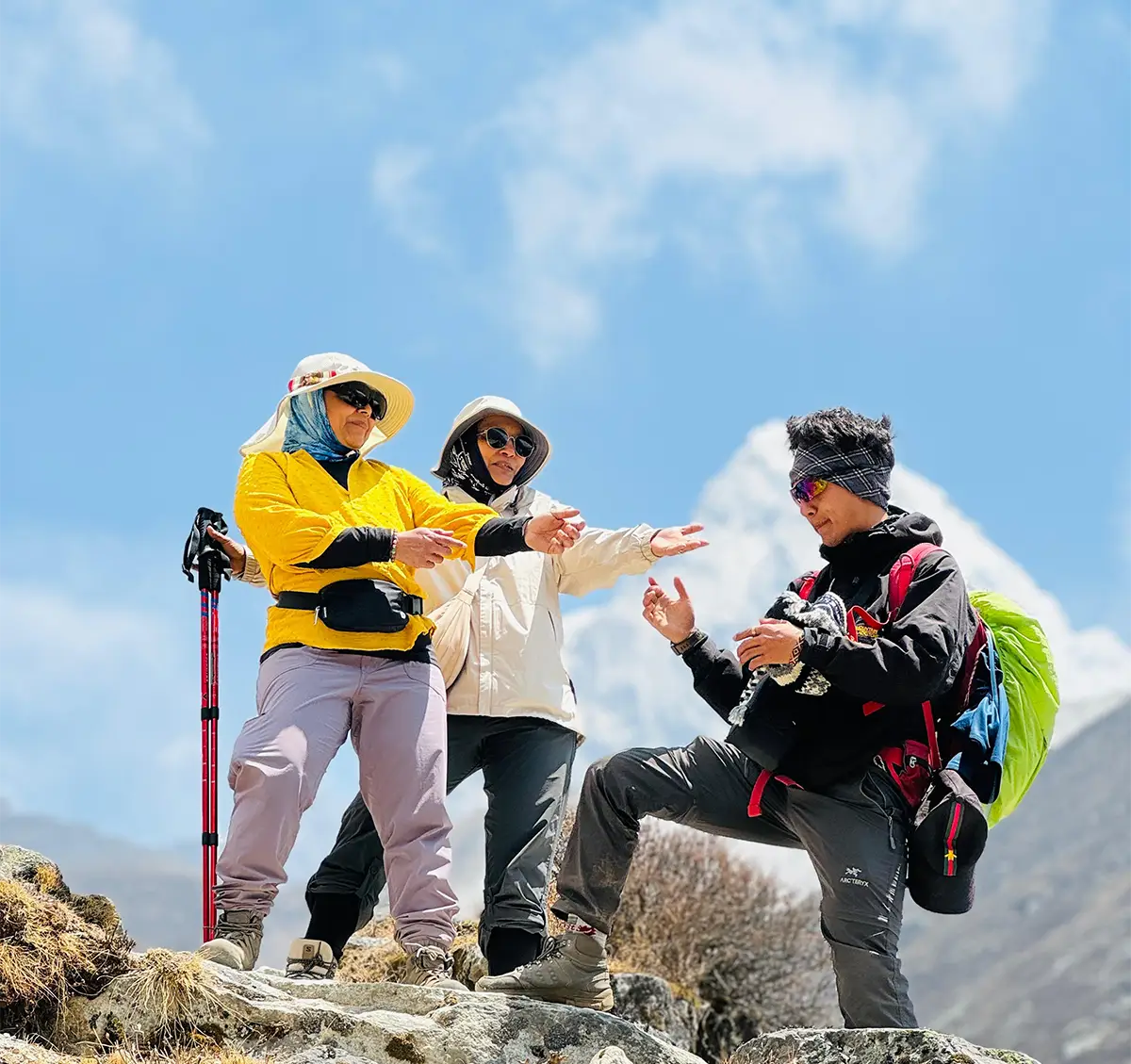
Guide to Accommodation and Facilities
The Everest Base Camp trek offers diverse and comfortable lodging amidst stunning Himalayan scenery. Whether you crave essential tea house charm or luxurious lodge comforts, there’s something for every budget and preference.
Tea Houses: Your Cozy Mountain Retreat
Tea houses are the most prevalent form of accommodation on the EBC trek. These welcoming lodges provide essential amenities like shared rooms, dining spaces, and occasionally hot showers. They also serve diverse meals, snacks, and beverages to energize you throughout your trek. While facilities may be essential, tea houses offer a unique chance to mingle with fellow trekkers and experience the genuine warmth of the Sherpa people.
Lodges and Hotels: Elevated Comfort in the Himalayas
Several lodges and hotels line the trek for those desiring a more upscale experience. These establishments boast private rooms with modern amenities like en suite bathrooms, Wi-Fi, and even rejuvenating spas. While pricier, they offer a haven of comfort and relaxation after a long day of trekking.
Camping: Embrace Nature’s Majesty
Camping is an alternative for those who yearn to sleep beneath the stars and connect with the Everest region’s natural splendor. However, camping demands extra gear and planning, making it ideal for seasoned trekkers or those with a guide. Some organized treks also offer camping options, providing tents, meals, and other essentials.
Nourishment for the Trail: Food and Water
Throughout the EBC trek, you’ll encounter numerous tea houses and lodges serving delectable local and international cuisine. A menu staple is the traditional Nepali dish of Dal Bhat, a satisfying combination of lentil soup, rice, and vegetables. You’ll also find momos (dumplings), noodles, and snacks to satisfy your hunger.
While bottled water is available, consider bringing a reusable water bottle and purifying water from natural sources using tablets or a filter. This eco-friendly option can also save you money.
Medical Facilities and Staying Safe
The Everest region houses several medical facilities to address altitude sickness and other emergencies. Nevertheless, prepare by carrying a basic first-aid kit. Here are some additional tips:
- Acclimatize properly to ward off altitude sickness.
- Learn to recognize altitude sickness symptoms and act if you experience them promptly.
- It’s essential to have travel insurance that includes medical evacuation coverage.

Scaling New Heights: Everest Base Camp’s Altitude and Terrain
Everest Base Camp (EBC) in Nepal, a mecca for trekkers and mountaineers, is breathtakingly 5,364 meters (17,598 feet) above sea level. This significant elevation places it squarely in the “death zone,” where the thin air can pose challenges for many. Understanding the altitude and unique terrain is vital to a safe and successful trek to Everest Base Camp.
Altitude at Everest Base Camp: A True Test
The Everest Base Camp altitude presents a unique hurdle for trekkers. With significantly less oxygen than at sea level, the thin air makes breathing more difficult and increases the risk of altitude sickness. Acclimatization is crucial for your body to adjust. Trekkers should ascend slowly, incorporate rest days, and stay well-hydrated to minimize altitude-related risks.
Everest Base Camp Terrain: A Landscape of Diversity
The trek to Everest Base Camp winds through a varied landscape, encompassing lush forests, rushing rivers, rocky paths, and glaciers. The terrain is demanding, with steep climbs and descents, uneven trails, and high-altitude conditions. Trekkers must prepare for diverse weather conditions, including sunshine, rain, snow, and strong winds.
Everest Base Camp Weather: Prepare for the Unexpected
Weather conditions in the Everest region are highly variable and can change unexpectedly. However, general patterns exist for each season:
- Spring (March-May): Mild temperatures, clear skies, and occasional snowfall.
- Summer (June-August): The monsoon season brings heavy rainfall, cloudy skies, and limited visibility.
- Autumn (September-November): Clear skies, cooler temperatures, and occasional snowfall.
- Winter (December-February): Frigid temperatures, heavy snowfall, and strong winds.
Gearing Up for NBC’s Terrain and Weather
Proper preparation for terrain and weather is crucial for a safe Everest Base Camp trek:
- Physical Fitness: Train for several months before trekking to build endurance and strength.
- Acclimatization: Ascend gradually and take rest days to help your body adjust to the altitude.
- Gear: Pack suitable clothing for changing weather conditions, including layers, waterproof gear, and warm clothing.
- Footwear: Invest in sturdy hiking boots with excellent ankle support.
- Navigation: Carry a map, compass, or GPS device, and familiarize yourself with the route.
- Hydration and Nutrition: Maintain your energy levels by staying hydrated and eating a balanced diet.
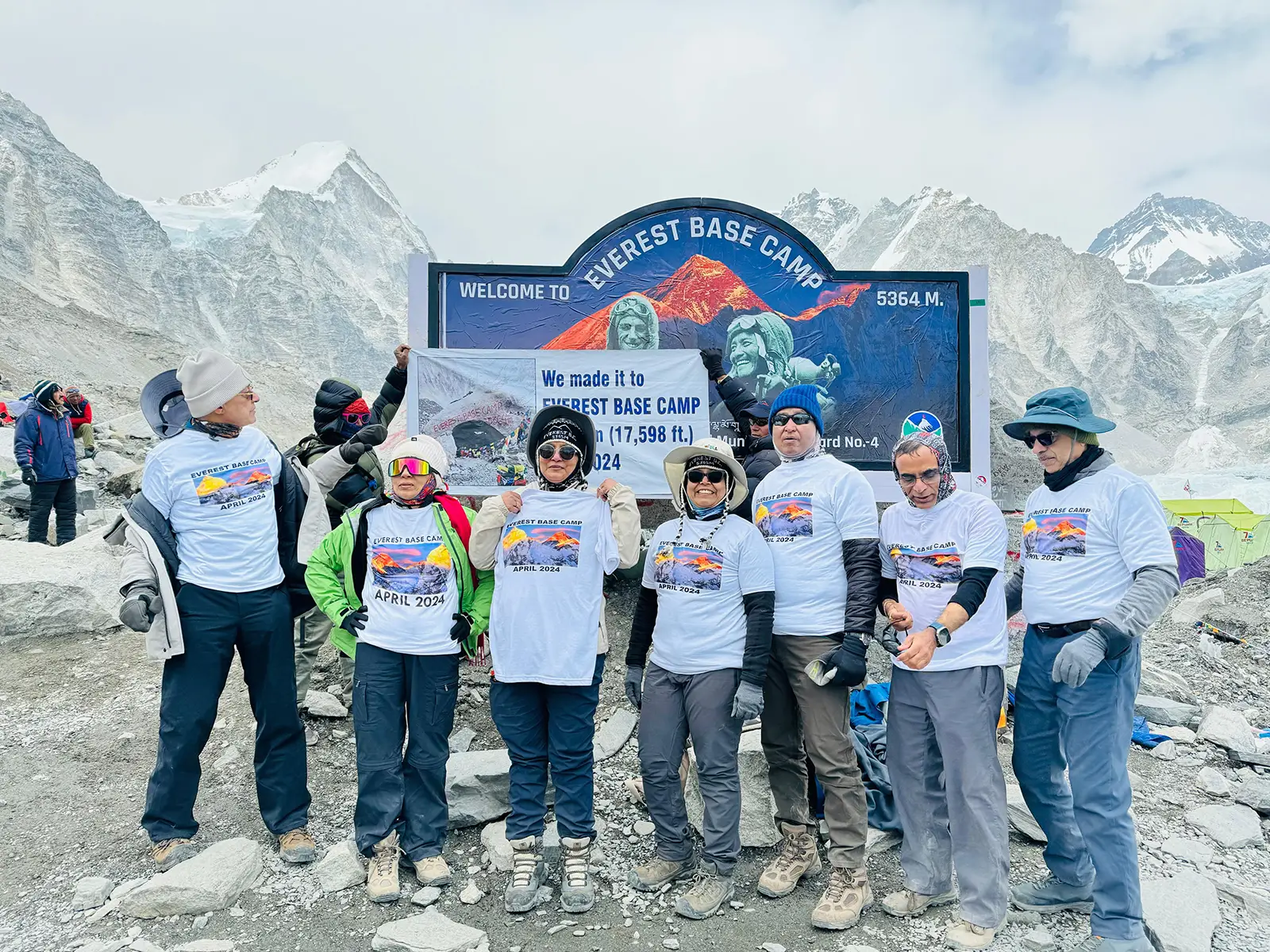
Everest Base Camp Camping: Your Guide to an Unforgettable Himalayan Slumber
Camping at Everest Base Camp (EBC) offers an unparalleled experience, immersing you in the raw, untamed beauty of the Himalayas with an unobstructed view of the world’s tallest peak. Discover essential knowledge and practical tips for an eco-friendly Everest Base Camp camping trek.
Choosing Your Campsite: Everest Base Camp Camping Spots
Everest Base Camp is a staging ground for expeditions, so it’s designated for something other than camping. However, you’ll find established camping areas nearby. Gorakshep, a short hike from EBC, provides the most convenient options. Other campsites along the trekking route, such as Dingboche and Lobuche, if you’re on a guided trek, your agency will likely handle the camping logistics.
Respect the Rules: Everest Base Camp Camping Regulations
Specific rules govern camping at Everest Base Camp to safeguard the delicate ecosystem of the Everest region:
- Obtain a Permit: You’ll need a Sagarmatha National Park permit to camp.
- Camp in Designated Areas: Stick to designated areas to minimize environmental footprint.
- Pack Out All Trash: Leave no trace by carrying out all your trash, including food scraps and toilet paper.
- No Campfires: Campfires are strictly forbidden to protect the natural vegetation.
Gear Up for the Elements: Everest Base Camp Camping Essentials
High-altitude camping demands specialized gear to withstand harsh conditions. Here’s what you’ll need:
- Four-Season Tent: A robust tent designed for extreme weather is a must.
- Warm Sleeping Bag: Choose one rated for temperatures well below freezing to stay cozy.
- Sleeping Pad: Ensure insulation and comfort on the rocky terrain with a quality sleeping pad.
- Cooking Stove and Fuel: Prepare hot meals and drinks with a reliable stove and fuel.
- Headlamp or Flashlight: Navigate the darkness safely with a dependable light source.
- Warm Clothing Layers: Pack a down jacket, thermal base layers, and waterproof outer layers for protection against the elements.
Leave No Trace: Eco-Friendly Camping at Everest Base Camp
We must preserve the pristine environment of the Everest region for generations to come. Embrace these Leave No Trace principles while camping:
- Pack It In, Pack It Out: Pack out all your trash.
- Avoid Campfires: Use a camp stove for cooking to minimize your impact.
- Stick to Durable Surfaces: Camp only on established sites to avoid harming vegetation.
- Respect Wildlife: Observe animals from afar and avoid disturbing their natural habitat.
Capturing Himalayan Majesty: Your Everest Base Camp Photography Guide
The Everest Base Camp (EBC) trek in Nepal presents photographers with a visual feast, from towering peaks and vibrant prayer flags to unique cultural moments. With proper preparation and a few techniques, you can capture stunning photos that will forever immortalize your Everest Base Camp trek. This guide shares tips to elevate your photography and highlights the most picturesque spots along the trek.
Essential Tips for Photographing Everest Base Camp
- Plan Your Shots: Research your destinations and visualize the images you want to create. It will maximize your time and optimize lighting conditions.
- Pack the Right Gear: A camera with manual settings is a must. A wide-angle lens captures landscapes, a telephoto lens zooms in on mountains, and a tripod ensures stability.
- Embrace Natural Light: Sunrise and sunset, the golden hours, offer dramatic lighting. Avoid the harsh midday sun, which can wash out colors and create stark shadows.
- Get Creative with Angles: Don’t just shoot from eye level. Crouch low or find a higher vantage point for unique perspectives.
- Incorporate People: The Sherpa people and fellow trekkers add a human touch to your photos, telling a richer story of your Everest Base Camp experience.
- Focus on Details: Look for captivating details like prayer flags, mani stones, and yak caravans.
Picture-Perfect Spots Along the Trek
The Everest Base Camp trek boasts countless breathtaking viewpoints. Here are a few must-visit spots:
- Namche Bazaar: Namche Bazaar is a vibrant Sherpa village that frames stunning views of Ama Dablam, an iconic peak in the Everest region.
- Tengboche Monastery: Perched on a hilltop, this ancient monastery offers sweeping vistas of Everest, Lhotse, and Ama Dablam.
- Dingboche: Towering peaks like Ama Dablam, Lhotse, and Island Peak encircle this picturesque village.
- Lobuche: Get your first glimpse of Everest Base Camp, nestled at the foot of the Khumbu Icefall.
- Gorakshep: This last stop before EBC offers incredible views of Everest and its surrounding mountains.
- Kala Patthar: A short hike from Gorak Shep leads to Kala Patthar, a 5,545-meter (18,192-foot) viewpoint that offers the best panoramic views of Everest.
- Everest Base Camp: Many trekkers make Everest Base Camp their ultimate goal. It provides a close-up view of the Khumbu Icefall and the start of the Everest climb.
Embracing Sherpa Culture
Trekking to Everest Base Camp (EBC) in Nepal offers more than breathtaking scenery. It’s a chance to connect with the vibrant Sherpa culture in this Himalayan region. Understanding and respecting local customs will unlock a more profound and rewarding experience.
Understanding the Heart of Sherpa Culture
We celebrate the Sherpa people for their mountaineering expertise, warm hospitality, and deep bond with the mountains. Their culture is deeply rooted in Buddhism, and their way of life intertwines with the natural environment. Critical aspects of Sherpa culture include:
- Hospitality: Sherpas are renowned for their welcoming nature and generosity. When you visit a Sherpa home or tea house, expect warm smiles and a cup of tea.
- Buddhism: Buddhism is central to Sherpa life, and monasteries and prayer flags scatter the landscape. During your trek, you might witness religious ceremonies and learn about Buddhist philosophy.
- Connection to Nature: Sherpas deeply respect nature and the mountains, which they consider sacred. They strive to live harmoniously with the environment and minimize their impact.
Connecting with Local Communities
One of the most enriching aspects of the EBC trek is the chance to interact with local Sherpa communities. You’ll encounter them in villages along the trail, learning about their daily lives, traditions, and perspectives. Here’s how you can connect respectfully:
- Learn a Few Phrases: A few words in the Sherpa language can go a long way in showing respect and appreciation.
- Show Respect: Remember, you’re a guest in their home. Ask permission before taking photos, dress modestly, and avoid behaviors that may be deemed offensive.
- Support Local Businesses: Purchase souvenirs from local shops and dine at local establishments to support the economy and promote sustainable tourism.
Respecting Local Customs and Traditions
For a harmonious and respectful experience, be mindful of local customs:
- Walk Clockwise Around Stupas: You should circumambulate Buddhist monuments like stupas clockwise.
- Remove Your Shoes: Shoes off when entering monasteries or homes.
- Don’t Touch Prayer Flags: These are considered sacred and should not be touched or moved.
- Avoid Public Displays of Affection: Nepali culture generally disapproves of public displays of affection.
- Ask Before Taking Photos: Always seek permission before photographing people, especially monks and nuns.
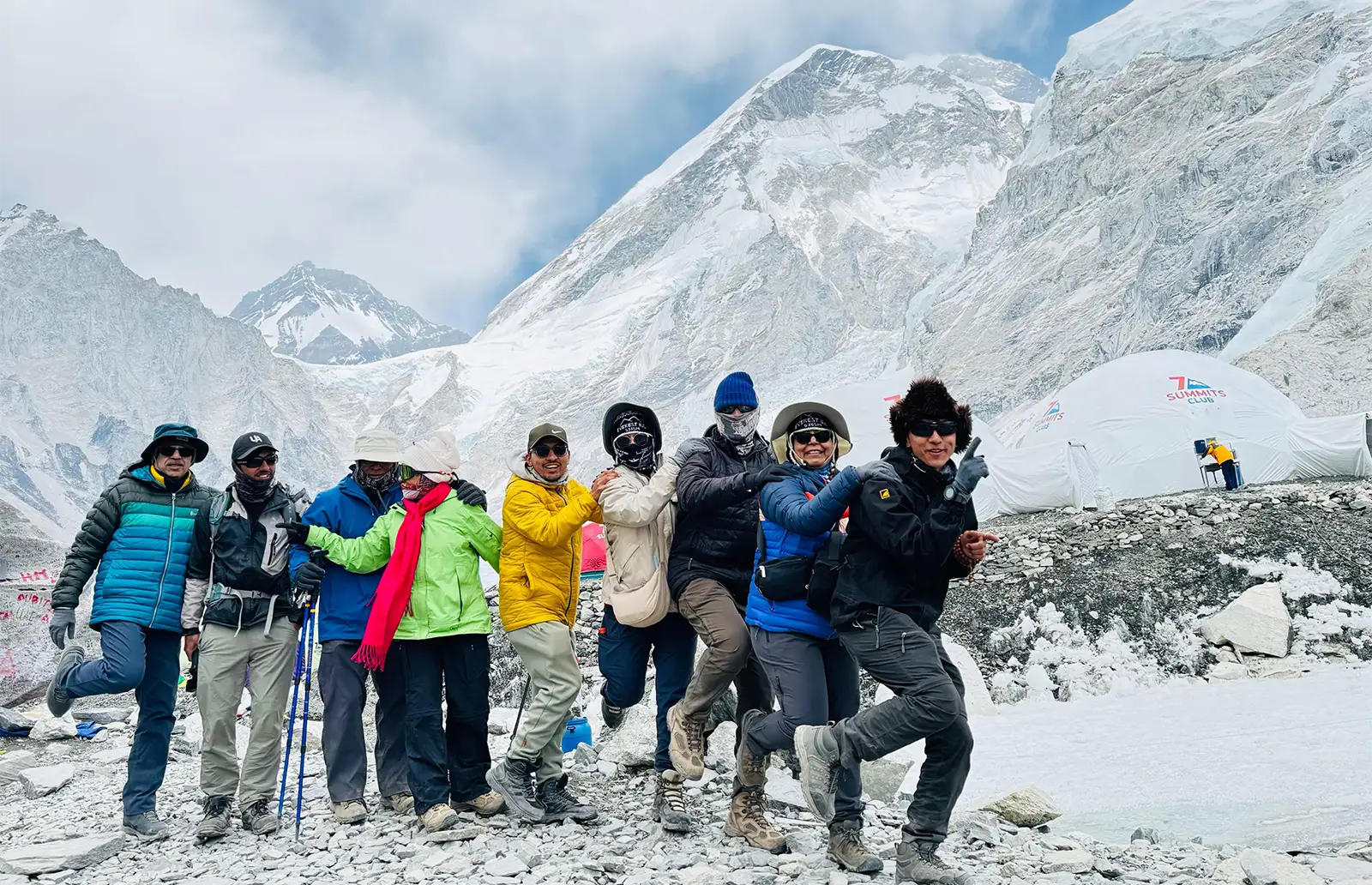
Prioritizing Your Safety
Trekking to Everest Base Camp (EBC) in Nepal is an exhilarating challenge, but the high altitude demands attention to health and safety. With proper preparation and precautions, you can ensure a safe and memorable Himalayan trek.
Staying Healthy at High Altitude
The most common health concern for EBC trekkers is altitude sickness, which can occur when your body struggles to adapt to the thin air. Common symptoms include headaches, nausea, dizziness, and fatigue. To prevent altitude sickness:
- Ascend Gradually: Allow your body time to adjust by ascending slowly.
- Hydrate: Hydration is essential; drink ample water and fluids.
- Avoid Alcohol and Caffeine: These can dehydrate you and worsen altitude sickness.
- Listen to Your Body: If you experience any symptoms, descend immediately.
Other health concerns to watch out for
- Cold and Flu: Pack warm clothes and maintain good hygiene to stay healthy.
- Stomach Issues: Be careful about what you eat and drink. Stick to cooked foods and bottled or purified water.
- Sunburn and Snow Blindness: Protect yourself from the sun’s harsh rays with sunglasses, a hat, and sunscreen.
- Safety First: Precautions for Everest Base Camp Trekking
Beyond health, other safety measures are crucial for your EBC trek:
- Hire a Guide or Porter: Enlist the help of a guide to navigate, find lodging, and share local knowledge. Hiring a porter can make your trek more enjoyable by carrying your heavy load.
- Check the Weather: Review the weather forecast before your departure and adjust your packing list accordingly.
- Stay Alert: Stay vigilant for dangers like slippery paths, falling rocks, and roaming yaks.
- Carry a First-Aid Kit: Be prepared for minor injuries by carrying a well-stocked first-aid kit.
- Share Your Itinerary: Inform a loved one of your trekking plans and expected return date.
Insurance and Emergency Evacuation: Be Prepared
Essential travel insurance must include medical emergency and evacuation coverage. High-altitude trekking is unpredictable, so having a plan for emergencies is critical. Ensure your policy covers helicopter evacuation from Everest Base Camp, the most common method in emergencies.
Trekking Tips for a Safe and Fun Experience
- Start Early: Begin your trek early in the day to reach your destination before dark.
- Take Breaks: Rest when needed and avoid pushing yourself too hard.
- Eat Well: Nourish your body with nutritious food for lasting energy.
- Enjoy the Scenery: Take time to appreciate the Everest region’s stunning views and unique culture.

Balancing Prosperity and Preservation in the Himalayas
The EBC trek in Nepal, a dream trek for many, presents a complex balance between economic opportunities and environmental challenges. Let’s explore how tourism impacts the local communities and the fragile Himalayan ecosystem around Everest Base Camp.
Tourism Fuels Local Economy
Tourism is a significant contributor to the economic development of the Everest region. The steady stream of trekkers and mountaineers creates jobs for the local Sherpa communities. They work as guides, porters, lodge owners, and souvenir sellers, contributing to the local economy and improving their quality of life.
Tourism’s Positive Economic Ripple Effects
- Increased Income: Tourism generates a substantial income for local communities, allowing them to invest in education, healthcare, and essential infrastructure.
- More Jobs: The tourism industry creates numerous employment opportunities for locals, reducing unemployment and raising living standards.
- Improved Infrastructure: The construction of lodges, tea houses, and trails has made remote areas more accessible, benefiting locals and tourists.
Environmental Challenges of Increased Tourism
While tourism brings economic prosperity, it also poses environmental threats to the Everest region. The growing number of visitors strains the delicate ecosystem, raising concerns about waste management, deforestation, and pollution. Environmental Concerns on the Rise:
- Waste Management: The accumulation of trash, including plastic bottles and food wrappers, is a growing problem. Proper waste disposal systems are crucial to maintain the pristine environment.
- Deforestation: Tourism significantly boosts the Everest region’s economy.
- Pollution: Human waste and litter can contaminate water sources and soil, posing health risks to locals and wildlife.
Sustainable Tourism: A Path Forward
The Everest region is undergoing a push towards sustainable tourism. These initiatives focus on safeguarding the environment while boosting the local economy. Key Sustainability Initiatives:
- Waste Management Programs: These encourage trekkers to pack out their trash and promote recycling and composting initiatives.
- Alternative Energy Sources: A priority is to invest in solar power and biogas plants to reduce reliance on firewood for energy.
- Community-Based Tourism: Empowering local communities to manage and benefit from tourism activities ensures a more equitable distribution of benefits.
Trekking Responsibly: Your Contribution
As a responsible trekker, you can contribute to the sustainable development of the Everest region:
- Pack Out Your Trash: Leave no trace of your visit by carrying out all waste, including food scraps and toilet paper.
- Use Refillable Water Bottles: Avoid single-use plastics by bringing your reusable bottle and purifying water.
- Choose Eco-Friendly Lodges: Support lodges that prioritize sustainability and implement eco-friendly practices.
- Support Local Businesses: Purchase souvenirs from local shops and dine at local restaurants to benefit the local economy.
